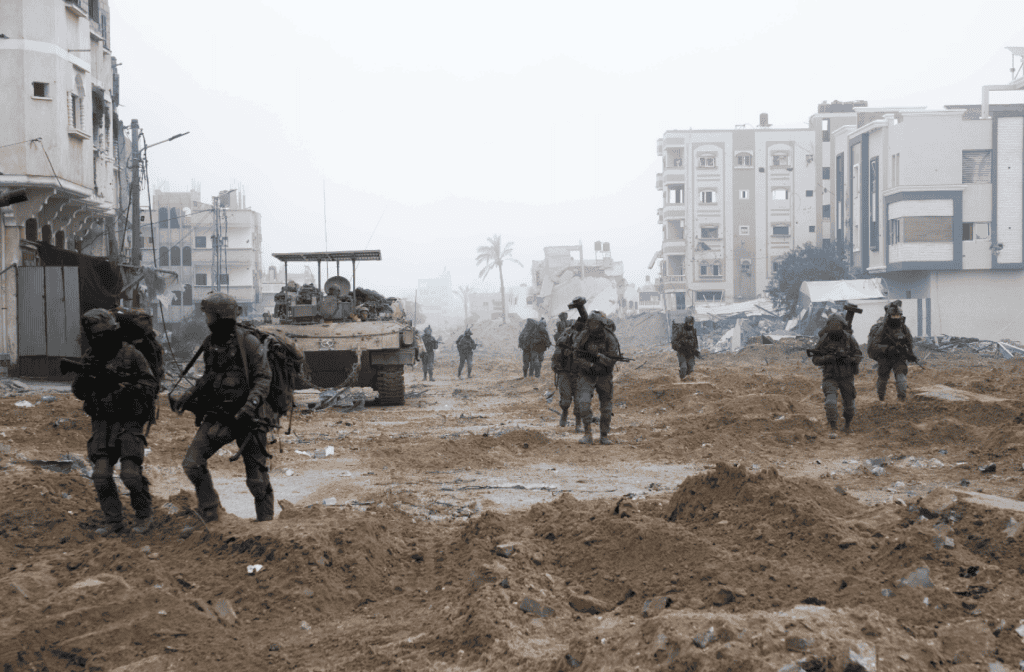
Israel Defense Forces eliminated fifteen Hamas terrorists in northern Gaza, the IDF said on January 31. In addition, two IDF soldiers — one of them from the elite air force Shaldag unit and the other from the 14th reserve brigade — were killed in northern Gaza. The IDF’s continued raids against terrorists and terrorist infrastructure in northern Gaza comes as Israel seeks to isolate the last remaining pockets of Hamas fighters in Khan Younis. The challenges in northern Gaza also illustrate that two months after the area was largely cleared of Hamas, the threats continue.
According to the IDF, operations continue in northern Gaza and the central Gaza strip. “In a significant targeted raid on terrorist infrastructure embedded inside a school in the area, approximately 10 Islamic Jihad terrorist operatives, who were using the school as a hideout, were apprehended by IDF troops. In addition, the troops located and destroyed five ready-to-fire rockets in the area,” the IDF said on January 31.
In addition, there were clashes in Shati Camp in northern Gaza. Shati refers to the area of the neighborhood which is next to the beach. It’s also built on a refugee camp established in the 1950s. As such, it is a warren of small streets and a heavily built-up area. The camp has been a stronghold of Hamas and other terrorist groups for many years. According to the IDF on January 31, a number of armed terrorists were spotted on the outskirts of Shati. “The troops conducted searches of military sites in the area in which they located large quantities of weapons, as well as documents and military equipment belonging to the Hamas terrorist organization,” the IDF said.
There are concerns about Hamas returning to northern Gaza. The Guardian reported on January 30 that “Hamas militants have returned to northern Gaza, where they are mobilising against Israeli forces and rebuilding a system of governance, aid officials, residents, analysts.” Most of northern Gaza was evacuated during the first two months of the war after October 7. However, an estimated 250,000 or more people remained in the north. The presence of Hamas among those civilians is difficult to quantify. However, the IDF’s continued work dismantling the terrorist infrastructure is a long-term process that requires time in the north and center of the strip. For instance on January 31, the IDF said that “in the northern Gaza Strip, IDF troops are continuing to enter Hamas military compounds and eliminate terrorists.”
In southern Gaza on February 1, the IDF identified a long-range missile launcher. It was struck by an aircraft. “Over the past day, the troops eliminated dozens of terrorists. Following the identification of a terrorist cell in central Gaza, IDF troops directed an aircraft that struck and eliminated a number of terrorists in the area,” the IDF said.
Israel is operating more in western Khan Younis, as well. This puts Israeli forces near the humanitarian area in Gaza called Mawasi. That is the area where many Gazans from the north fled in October and November. Israeli forces are now operating across the Gaza strip from east to west, essentially cutting off Rafah near the Egyptian border with central Gaza and the north. The only conduit for Hamas to move between these areas would likely be via the humanitarian area. This presents challenges as well, because the IDF does not want to operate in a densely packed area full of internally displaced people and is hesitant about operations near Rafah due to Egyptian concerns.
On January 31, the IDF said that it was continuing “extensive” activities in western Khan Younis. “Over the past day, IDF troops eliminated terrorists in the area in close-quarters combat. In addition, IDF troops directed several aircraft that struck and eliminated a number of terrorists in different areas.” The operations in Khan Younis have been like this for weeks, with daily airstrikes and a much lower intensity type of fighting than in the operations of November and December.







